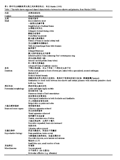Animal Group, Saunders Bioscience Instit
 作者
作者  通讯作者
通讯作者
基因组学与医学生物学, 2013 年, 第 2 卷, 第 2 篇 doi: 10.5376/gmb.cn.2013.02.0002
收稿日期: 2013年06月06日 接受日期: 2013年06月07日 发表日期: 2013年06月08日
 作者
作者  通讯作者
通讯作者
基因组学与医学生物学, 2013 年, 第 2 卷, 第 2 篇 doi: 10.5376/gmb.cn.2013.02.0002
收稿日期: 2013年06月06日 接受日期: 2013年06月07日 发表日期: 2013年06月08日
© 2013 BioPublisher 生命科学中文期刊出版平台
本文首次发表在 International Journal of Molecular Evolution and Biodiversity, 2012, Vol.3, No.1, 1~4 上。现依据版权所有人授权的许可协议,采用 Creative Commons Attribution License,协议对其进行授权,再次发表与传播。只要对原作有恰当的引用, 版权所有人允许并同意第三方无条件的使用与传播。
推荐引用:
Young P.A., 2012, Genomic Evidence Supported Treeshrew is Closely Related to Primates, International Journal of Molecular Evolution and Biodiversity, Vol.3, No.1, 1~4 (doi: 10.5376/ijmeb.2013.03.0001)
摘要
最新的树鼩全基因组测序数据支持这样一个观点:树鼩既不是食虫目也不是灵长目哺乳动物,但是与灵长类更接近;基因组测序证据基本澄清了关于树鼩系统发育位置存在的争议。确切的可以说树鼩是灵长类总目中树鼩目的一种较为原始的小型哺乳动物,其亲缘关系更接近灵长目动物。
关键词
树鼩;食虫动物;灵长类动物;树鼩目;灵长类总目
树鼩,是一类生活在南亚、东南亚热带地区的小型哺乳动物(图1)。树鼩与松鼠有许多共同的形态特征和行为特征,所以马来人把树鼩和松鼠统称为tupai (Lyon, 1913; Gould, 1978; Martin, 1990)。树鼩属名Tupaiia由此而来。所有的树鼩有一些共同的特点:相对较小的体量,一般杂食动物(以节肢动物和水果为食),骨骼似非专化有胎盘哺乳动物模式,所有的足趾有爪,手和脚不能弯卷(Gould, 1978; Martin, 1990)。近一个世纪以来(1922年以来),树鼩的分类地位一直悬而未决(Butler, 1972; Young, 2011)。
1树鼩是食虫目动物吗?
一些学者认为:根据树鼩的外形(吻部较长, 指(趾)端是爪, 牙齿的数目)和食性有食虫目的特征,应该分类到食虫目(Insectivora)。食虫目是由象鼩,地鼠,刺猬,马岛猬,鼹鼠,以及可能的树鼩。现在有人建议,把食虫目分为两个亚目Menotyphla (象鼩及树鼩)和Lipotyphla (地鼠, 刺猬, 马岛猬, 鼹鼠) (Haeckel, 1866; Weber, 1928; Martin, 1990)。人们已经注意到,与食虫目其它成员相比,树鼩有非常原始的有胎盘哺乳动物特征(Carlsson, 1922; Martin, 1990),树鼩是高级的食虫动物(Martin, 1990)。后来食虫目被发现是一个多系群,其成员陆续独立出来或被分置于其它目,食虫目因而被取消了(Hutterer, 2005)。
2树鼩是灵长类动物吗?
另一些学者则根据其头骨的特征,例如:大脑比较发达, 大脑上的嗅神经区较小,眼眶后有骨桥并形成骨性眼眶;以及某些原始的原猴类相似等特征,例如:中耳部构造与狐猴相似,大拇指(趾)与其它指(趾)分开及牙齿具有前臼齿)把它列入灵长目(Primates)中的狐猴亚目(Napier and Napier, 1967)。
3悬而未决的争议:分类地位
树鼩应该归属于食虫目,或是灵长目,还是应该介于两者之间,自成一目,一直存在非常大的争议(Butler, 1972,Young, 2011)。事实上,树鼩和灵长类动物之间有共享的特点,是有胎盘哺乳动物中的原始类型(Martin, 1990)。树鼩和灵长类动物有许多共有的特征和特性(表1),由此,有人把树鼩归目到Primata。然而,也有一些灵长类动物中共有的特征在树鼩中没有发现(Martin, 1990),树鼩也没有灵长类动物衍生出来的灵长目动物的特征,还有一些特征在任何其他哺乳动物中没有发现(Martin, 1990)(表2)。所以不能确切地说,树鼩是灵长目动物(Butler, 1972; Martin, 1990)。
树鼩从食虫目移到灵长目,是因为与灵长目有某些内在的相似性(例如Sir Wilfred Le Gros Clark强调的大脑解剖结构的相似性),并将其分类为原始prosimian。然而,线粒体基因组的分析表明,树鼩与兔形目Lagomorpha有更密切的关系,而不是皮翼目Dermoptera或灵长目(Xu et al., 2012)。分子细胞遗传学数据支持树鼩目—皮翼目Dermoptera为一个姐妹分支clade (Nie et al., 2008)。Hallström和Janke(2010)最近的一项研究基于3 000基因的系统发育分析,将树鼩分组到啮齿动物类(包括啮齿目和兔形目动物),并认为树鼩鼠或兔有更紧密的亲缘关系。但是,多个核基因证据表明树鼩和灵长类动物(包括人类)有更紧密的亲缘关系(Janecka et al., 2007, Lindblad-Toh et al., 2011)。这些最新的分子系统发育研究强烈地建议,树鼩应给予相同的与灵长目相同的目分类地位,与灵长目和飞狐猴类(colugos)一起,归属Euarchonta分支。根据这一分类,Euarchonta与啮齿动物(兔形目动物和啮齿动物)是姐妹分支,两个分支组合成Euarchontoglires分支(Bartolomucci et al., 2002)。
4树鼩是一种更接近灵长类的哺乳动物
北方树鼩(Tupaia belangeri chinensis)基因组测序的完成为树鼩分类上长期存在的争议提供了分子水平的证据。基于树鼩全基因组数据与其他包括6种灵长类种在内的14种,Fan等对2117个单拷贝基因进行分析,结果表明树鼩首先与灵长类物种集群,所有的系统发育分类信号具有很高的bootstrap支持,包括所有密码子的位置和肽序列的编码序列(图2)(Fan et al., 2013)。
进一步,Fan等在15个哺乳动物的基因组中估算分化时间(图2)(Fan et al., 2013)。研究结果表明:树鼩在距今约9 090万年前似乎已从涵盖6种灵长类动物的分化类群上分化出来,而啮齿动物类群从灵长类动物分化类群上分化出来相对较早,大约在9 640万年以前。树鼩与非人类灵长类动物较接近的亲缘关系,主要表现在系统进化树的聚类模式和相对较小的分化时间(Fan et al., 2013)。
5结论
树鼩全基因组数据基本上平息了关于树鼩发育位置存在的争议。确切的可以说:树鼩是灵长类总目中树鼩目的一种较为原始的小型哺乳动物,其亲缘关系更接近灵长目动物。
参考文献
Bartolomucci A., de Biurrun G., Czéh B., van Kampen M., and Fuchs E., 2002, Selective enhancement of spatial learning under chronic psychosocial stress, Eur. J. Neurosci., 15(11): 1863-1866
http://dx.doi.org/10.1046/j.1460-9568.2002.02043.x
PMid:12081667
Butler P.M., 1972, The problem of insectivore classification, In: Joysey K.A., and Kemp T.S. (eds), Studies in Vertebrate Evolution, Oliver and Boyd, Edinburgh, pp.253-265
Carlsson A., 1922, über die tupaiidae und ihre beziehungen zu den insectivora und den prosimiae, Acta Zoologica, 3(2-3): 227-270
http://dx.doi.org/10.1111/j.1463-6395.1922.tb01021.x
Fan Y., Huang Z.Y., Cao C.C., Chen C.S., Chen Y.X., Fan D.D., He J., Hou H.L., Hu L., Hu X.T., Jiang X.T., Lai R., Lang Y.S., Liang B., Sheng-Guang Liao S.G., Mu D., Ma Y.Y., Niu Y.Y., Sun X.Q., Xia J.Q., Xiao J., Xiong Z.Q., Xu L., Yang L., Zhang Y., Zhao W., Zhao X.D., Zheng Y.T., Zhou J.M., Zhu Y.B., Zhang G.J., Wang J., and Yao Y.G., 2013, Genome of the Chinese tree shrew, Nature Communications, 4: 1426
http://dx.doi.org/10.1038/ncomms2416
PMid:23385571
Gould E., 1978, The behavior of the moonrat, Echinosorex gymnurus (Erinaceidae) and the pentail Tree-shrew, Ptilocercus lowii (Tupaiidae) with comments on the behavior of other insectivora, Zeit. Tierpsychol., 48: 1-27
http://dx.doi.org/10.1111/j.1439-0310.1978.tb00245.x
Haeckel E., 1866, Generelle morphologie der organismen: allgemeine grundzuge der organischen formen-wissenschaft, mechanisch begründet durch die von charles darwin reformierte descendenz-theorie (2 vols.), Georg Reimer, Berlin
http://dx.doi.org/10.5962/bhl.title.3953
Hallström B.M., and Janke A., 2010, Mammalian evolution may not be strictly bifurcating, Mol. Biol. Evol., 27(12): 2804-2816
http://dx.doi.org/10.1093/molbev/msq166
PMid:20591845 PMCid:2981514
Hutterer R., 2005, Order Soricomorpha, In: Wilson D.E., and Reeder D.M. (eds), mammal species of the world, Johns Hopkins University Press, pp. 220-311., Baltimore, Maryland, USA, pp.220-311
Janecka J.E., Miller W., Pringle T.H., Wiens F., Zitzmann A., Helgen K.M., Springer M.S., and Murphy W.J., 2007, Molecular and genomic data identify the closest living relative of primates, Science, 318(5851): 792-794
http://dx.doi.org/10.1126/science.1147555
PMid:17975064
Lindblad-Toh K., Garber M., Zuk O., Lin M.F., Parker B.J., Washietl S., Kheradpour P., Ernst J., Jordan G., Mauceli E., Ward L.D., Lowe C.B., Holloway A.K., Clamp M., Gnerre S., Alföldi J., Beal K., Chang J., Clawson H., Cuff J., Di Palma F., Fitzgerald S., Flicek P., Guttman M., Hubisz M.J., Jaffe D.B., Jungreis I., Kent W.J., Kostka D., Lara M., Martins A.L., Massingham T., Moltke I., Raney B.J., Rasmussen M.D., Robinson J., Stark A., Vilella A.J., Wen J., Xie X., Zody M.C., Broad Institute Sequencing Platform and Whole Genome Assembly Team, Baldwin J., Bloom T., Chin C.W., Heiman D., Nicol R., Nusbaum C., Young S., Wilkinson J., Worley K.C., Kovar C.L., Muzny D.M., Gibbs R.A., Baylor College of Medicine Human Genome Sequencing Center Sequencing Team, Cree A., Dihn H.H., Fowler G., Jhangiani S., Joshi V., Lee S., Lewis L.R., Nazareth L.V., Okwuonu G., Santibanez J., Warren W.C., Mardis E.R., Weinstock G.M., Wilson R.K., Genome Institute at Washington University, Delehaunty K., Dooling D., Fronik C., Fulton L., Fulton B., Graves T., Minx P., Sodergren E., Birney E., Margulies E.H., Herrero J., Green E.D., Haussler D., Siepel A., Goldman N., Pollard K.S., Pedersen J.S., Lander E.S., and Kellis M., 2011, A high-resolution map of human evolutionary constraint using 29 mammals, Nature, 478(7370): 476-482
http://dx.doi.org/10.1038/nature10530
PMid:21993624 PMCid:3207357
Lyon M.W., 1913, ed., Treeshrews: an account of the mammalian family tupaiidae, Proceedings of the United States National Museum, USA, 45: 1-186
Martin R.D., ed, 1990, Primate origins and evolution: a phylogenetic reconstruction, Princeton University Press, Princeton, N.J., pp.828
Napier J.R., and Napier P.H., eds., 1967, A Handbook of Living Primates, Academic Press, London
PMCid:1270938
Nie W., Fu B., O'Brien P., Wang J., Su W., Tanomtong A., Volobouev V., FergusonSmith M., and Yang F., 2008, Flying lemurs-the 'flying tree shrews'? Molecular cytogenetic evidence for a Scandentia-Dermoptera sister clade, BMC Biol., 6: 18
http://dx.doi.org/10.1186/1741-7007-6-18
PMid:18452598 PMCid:2386441
Weber M., 1928, Die saugetiere: einfuhrung in die anatomie und systematik der recenten und fossilen mammalia, vol. 1: anatomischer teil (2nd edition), Gustav Fischer Verlag, Jena
Xu L., Chen S.Y., Nie W.H., Jiang X.L., and Yao Y. G., 2012, Evaluating the phylogenetic position of Chinese tree shrew (Tupaia belangeri chinensis) based on complete mitochondrial genome: implication for using tree shrew as an alternative experimental animal to primates in biomedical research, J. Genet. Genomics, 39: 131-137
http://dx.doi.org/10.1016/j.jgg.2012.02.003
PMid:22464472
Young P.A., 2011, Treeshrews, the primitive primate mammals for medical experimental animals, Intl. J. of Molecular Zoology, Vol.1, No.2, 4-6 (doi: 10.5376/ijmz. 2011.01.0002)
基因组学与医学生物学
• 第 2 卷



